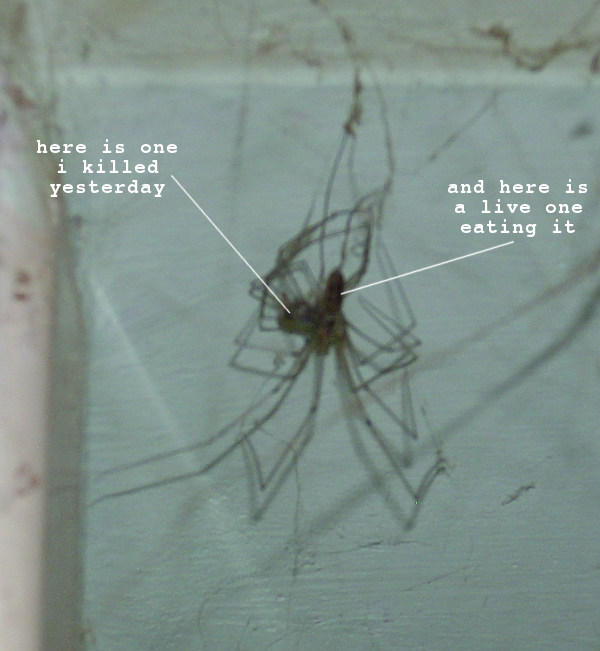
I fucking hate pholcid spiders. They are cunts. They are shit spiders to begin with because they are fucking ugly. They are not really very good at killing insects - sure they can manage to kill even quite large ones, but they don't kill very many, so they are not usefully good at it. And worst of all, they eat other spiders (ones which do kill insects), so it ends up that there are no proper spiders around at all, just loads of these fucking pholcid cunts instead. Even the bloody cat won't chase them, so they must be shit.
So I have decided to do something about it, and kill all the fucking pholcids to give the proper spiders a chance. (It works, too. Since initiating the pholcid extermination programme I have noticed a large increase in the number of proper spiders - as in now there are quite a few of them, of several different species, whereas before there weren't any - and a decrease in the number of insects that are about.)
(Skip to: Coanda effect - Egg sacs - Tensile failure of integument - Laser method - Tolkien's method)
The best way to kill them is with a lighter, because they are fucking vile even to squash. Huge blobs of repulsive grey gunge come out of them and smear over everything. Doing them with a flame is much neater.
It also has the advantage that the dead pholcid usually stays more or less where it is, tangled in the strands of web that didn't get caught in the lighter flame. That may not seem like much of an advantage, but in fact it is. Pholcus phalangoides not only eats other spiders, it eats other members of its own species as well, provided they are already dead. So the dead pholcids hanging in the remains of the web act as bait to attract live ones. The live ones eat the dead ones where they find them, and they take a long time doing it, so there is plenty of opportunity to spot the cannibalistic little shits and set fire to them too.
Here is a picture of a cannibal pholcid eating another one that I killed the previous day. Sorry about the shit photo. The autofocus on this camera is fucking shite and it doesn't have a manual focus, so there's not much I can do when it decides not to work properly.

The principal means by which pholcids and other spiders extend their legs is by contracting muscles that increase the hydrostatic pressure of the fluid within the legs, which are essentially fluid-filled tubes with kinks in (the "joints"); increasing the internal pressure straightens out the kinks and extends the leg. The effect of applying a lighter flame to a pholcid is to rapidly heat its bodily fluids; since the legs are very thin their thermal capacity is very small and the fluid in them reaches boiling point more or less instantly. The consequent rapid increase in internal pressure causes the legs to straighten violently and in some cases blows them right off the body. This phenomenon is accompanied by a characteristic snapping and whistling sound caused by the escaping steam. The result can be seen in this photo, taken after I had boiled the spider that was alive in the previous pic. Most of its legs are completely dead straight, and some of them are missing. Furthermore it straightened them sufficiently violently to throw the mangled remains of the one it was eating away from itself, so now the two wee shites are quite a distance apart.
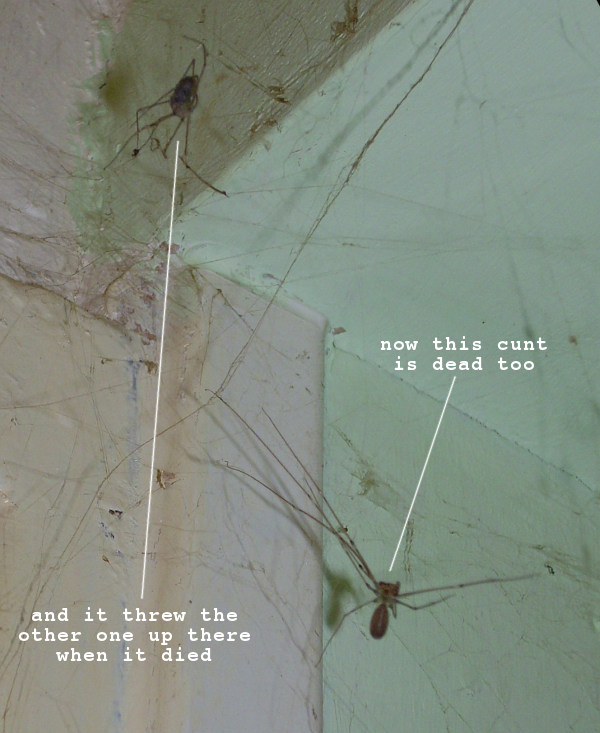
You can't really see them in the photo but the newly dead one's legs are covered with very small spherical globules which were not there before it was dead. These are composed of internal fluids forced out through any available weak spot in the exoskeleton by the steam pressure. They come out all over, not just at the joints. Probably they are coming out where the hairs do but the hairs are too small to see without some decent magnification so I'm not sure.
Sometimes a boiled pholcid will stick to the wall. I am not sure, but I suspect it may be these globules of extruded body fluids which glue them there.
Sometimes a pholcid will take alarm at the approach of the lighter and make its escape before the flame can be ignited. When a pholcid has taken up residence on a flat surface it is possible to make use of the Coanda effect to increase the kill probability. By holding the lighter somewhat further away from the pholcid than usual and pressing the button only part way down, a cloud of butane is created which clings to the wall rather than dispersing as it would in open air. The button is then pressed fully down, operating the igniter, and the entire cloud of butane catches light all at once with the pholcid in the middle of it, boiling it before it can even think of escape.
Sometimes a pholcid can be seen with a ball of tiny beads attached to its head. This is an egg sac, and is further proof that pholcids are shit because as every bird knows you are supposed to sit on eggs, not put them on your fucking head. It is important to ensure that all the eggs are thoroughly cooked as well as the pholcid carrying them, to make sure they do not hatch. The recommended procedure here is to transfer the pholcid, once it is dead, to a suitably flameproof surface (to avoid the problem of its legs burning off and it falling on the floor and getting lost before the operation is complete) and then apply the lighter flame to the egg sac for as long as required. It takes a while before the heat starts to have an effect, but once it does, the eggs begin to burst, one by one. Each bursting egg makes a distinct pop and causes a pustule-like excresence to erupt on the surface of the egg sac. It is quite entertaining and certainly saves a fuck load of hassle compared to hunting down and burning all the new pholcids if the eggs had been allowed to hatch.
Here is a photo showing another interesting pholcid deletion scenario. This pholcid was on the ceiling, and so beyond the direct reach of the lighter flame, unless I climbed on a chair or something which I couldn't be arsed to do. So I simply held the flame beneath it and allowed the rising hot gases to boil it slowly. After maybe 10 seconds or so it fell off and hit the floor, and this was the result:
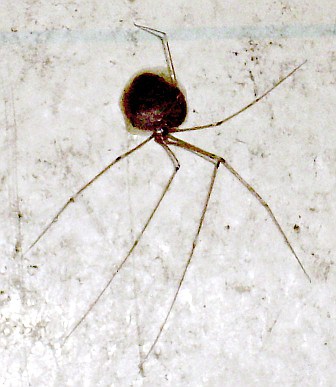
It was an obscenely fat and bulging specimen even before it was cooked, its foul integument taut and shiny and thoroughly vile. The heating appears to have both weakened its structure and raised its internal pressure through thermal expansion of its bodily fluids. When it hit the floor, the impact caused the already weakened and stressed containment to burst, and what remained was a tangle of legs sticking up out of a gooey little puddle of parboiled pholcid body fluids. This can be seen in the picture as the circular brown blob, with a ring of clearer fluid around the perimeter.
It is even more entertaining when the tensile integument failure occurs explosively. This one was so taut and bulging that it looked as if it was about to burst of its own accord anyway. I kept it under heating from a cooler part of the flame for about 20 seconds, after which there was a distinct pop, and this happened:
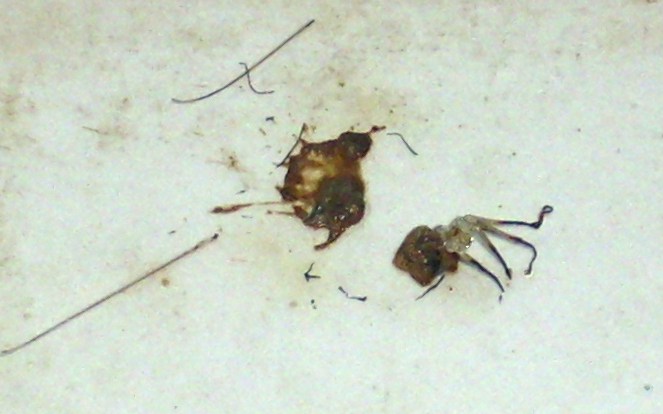
On the right is the burst body of the pholcid, attached to the remains of its legs, which of course burnt off at the very beginning of the heating. In the middle is the blob of gunge, part liquid and part solid, which shot out of it when it exploded. On the left are a couple of remnants of leg.
Another method of deleting pholcids which has much to recommend it is to use a laser. Both the power and the wavelength of the laser are of significance. It is surprisingly difficult to aim the laser accurately at the pholcid; the extreme brightness of the spot makes it hard to work out what it's actually hitting, and it is quite easy to end up merrily lasering the wall behind the pholcid without actually realising. One way around this problem is to use a wavelength such as 808nm, to which the eye is not very sensitive so the laser spot appears quite dim even though the laser is powerful. 808nm laser diodes in powers up to 5W are readily available, but at present I only have a 300mW one, and this isn't really powerful enough, especially as the beam quality is absolutely shite and focussing it down to a tight spot would require far more elaborate optics than I've got.
A 500mW 405nm laser is approaching the tail of the other end of the eye's range of sensitivity, and since such laser diodes are mostly manufactured for use in high speed Blu-ray writers where beam quality is important, they can readily be focussed to a very fine spot. While the greater dazzle factor makes it harder to aim, its lethality to the pholcid is considerably greater, although it is still necessary to chase the bastard thing around a bit with the beam before it dies.
The 808nm and 405nm wavelengths have an additional advantage in that pholcids don't seem to see these wavelengths well either, so they do not attempt evasive action until it actually starts to cook them. They do, however, appear to be able to see 445nm quite well, so at this wavelength chasing them with the beam is significantly harder, and the beam is much harder to aim in the first place because the dazzle factor is very large. Therefore it is necessary to use a high enough power laser to significantly cripple the pholcid as soon as the beam first hits it. As long as the focus is carefully adjusted, a 1.4W laser will generally do the trick (a higher power would be advantageous but significantly higher power 445nm laser diodes are not easy to find). Such a laser will not kill the pholcid straight away, but it does stand a good chance of damaging it sufficiently that its efforts to evade further lasering are significantly hampered, and of course the greater the dose integral becomes the slower it moves and it doesn't take long to be able to finish it off.
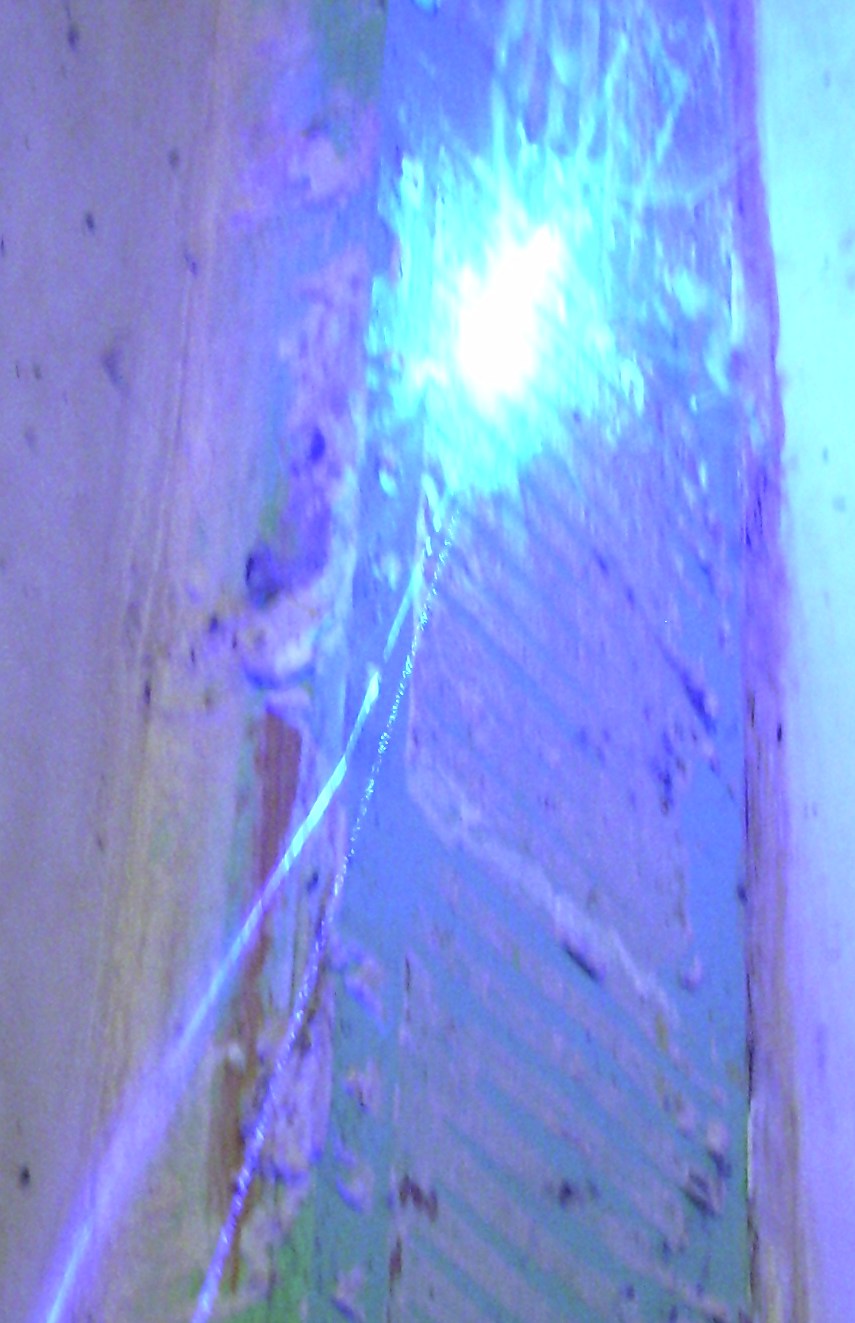
The camera does not cope well with the extremes of brightness generated by the laser. The pholcid upon which the beam is impinging cannot be seen as the entire area is washed out. However, the camera has managed to record the blue-lit smoke which the pholcid is emitting as it burns, in the form of streaks and smears above and to the right of the laser spot.
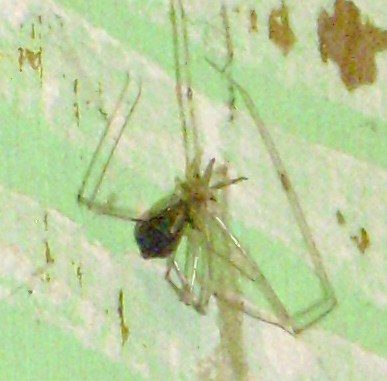
Holding the laser with one hand and the camera with the other and trying to get a photo that worked was not all that easy, and there was not much left of the pholcid by the time I'd finished.
As well as being enjoyably sci-fi-esque, laser pholcid deletion has a further advantage in that the pattern of movements of a partly-lasered pholcid can come to resemble that of a prey species. The one currently in course of destruction accordingly becomes a lure for others that may be lurking in nearby crevices, and draws them out into the open where they can be lasered in their turn.
Another method, less exotic perhaps but far more practical with the technology of the time, is described by JRR Tolkien in a letter to his son Michael, who appears to have been something of a kindred spirit in the matter of his opinion of pholcids. While on holiday in Switzerland - that same holiday which provided the inspiration for the scree-slope scene in The Hobbit - he stayed in a chalet which turned out to be infested with the things, and he and his party entertained themselves by eliminating them using the method of "dropping hot wax from a candle onto their fat bodies". The chalet staff, apparently, did not approve, but I certainly do. While I have not tried this personally - since the great majority of the ones I find myself needing to exterminate are positioned so as to require a device which can be aimed upwards - it does sound like a most excellent method, combining effectiveness with entertainment as all good pholcid elimination methods should. One can only speculate on the possible consequences for Middle-earth had the Valar thought of making a huge giant massive fuck-off candle when the need arose to deal with Ungoliant. It is said that the clouds of darkness which she emanated absorbed all light and threw off the Valar, who were chasing her on the ground, but there is nothing to indicate any ability to absorb an aerial hot wax bombardment.
I fucking hate pholcids.
Back to Pigeon's Nest
Be kind to pigeons